3-D Printing: Veterinary Medicine Benefits and Use

How It Works
Using information from CT scans and x-rays, software of a computer-aided design (CAD) program is used to virtually design two-dimensional drawings or three-dimensional models which can be manipulated to fit the individual needs of the veterinary patient. The software information is then applied and utilized by the 3-D printer in order to create a dimensionally correct model that can be used in many applications.
The 3-D model begins on a flat base. From the base, the printer extrudes layer upon layer of material in specific dimensions by following the CAD program’s instructions.
The list of materials available for use in 3-D printing continues to grow, and includes, for example:
- Plastic
- Resin
- Metal
- Ceramic
- Glass
- Living cells
Benefits of 3-D Printing
Utilizing 3-D printing within veterinary medicine provides multiple advantages. Having a physical model of accurate dimensions that can be held and viewed from all angles helps to:
- Plan for procedures by identifying abnormalities and/or damage
- Customize instruments and devices for use before procedures
- Create surgical incision templates
- Produce models for bone replacement
- Facilitate the assessment of tumor removal
- Create prosthetic devices
- Design orthopedic implant devices
- Aid in reconstruction surgeries
- Decrease surgery time, which:
- Decreases time an animal is under anesthesia
- Decreases risks of infection
3-D printing can also provide a benefit to veterinarians and staff when consulting with a client over their pet’s care. For example, having an actual model of their animal’s broken bone will help to explain the damage and the process required for treatment. Not only will the model aid the veterinarian in their diagnosis and determination of the right type of procedure, but it will also support their decision when discussing the animal’s needs with the client.
Use in Education
Three examples of utilizing a 3-D printer for educational use in the veterinary field include:
- The Ohio State University College of Veterinary Medicine
- 3-D printed models of bones created for veterinary student use to learn the procedures and gain the surgical skills required:
- To fix broken bones
- CT scans of the actual bones of canine patients were used to create 3-D printer models
- To correct bone deformities in dogs caused by either abnormal development or trauma
- University of Pennsylvania
- PennDesign’s Fabrication Lab works on 3-D printing technology in a collaborative effort with the School of Veterinary Medicine
- 3-D Model replications of animals with skull injuries or deformities are being used to improve student training and patient care
- Models offer the opportunity to practice surgical procedures before the start of an operation
- Full-colored models may advance surgical methods by distinguishing blood vessels and tissues
Applications in Clinic Use
Actual examples of the utilization of a 3-D printer for use by veterinarians include:
- Life-size 3-D model printing of a Yorkshire terrier’s vertebrae in preparation of performing ventral atlantoaxial stabilization
- Model gave veterinarian opportunity to:
- Practice procedure
- Refine the measurements needed for the instruments and tools
- 3-D model from a CT image of a horse with an comminuted orbital fracture
- Model allowed veterinarian:
- Opportunity to study the damage
- Be more precise with incisions
- Understand how to efficiently move the bones back into place
As the technology continues to evolve, veterinary medicine will continue to uncover ways to immerse the use of the 3-D printer into practice. Talk to your Covetrus representative at 855.724.3461 to discuss the best ways to take advantage of 3-D printing technology now.
Information gathered from:
http://news.vin.com/vinnews.aspx?articleId=30196
http://www.upenn.edu/spotlights/3d-printing-veterinary-surgeries
https://vet.osu.edu/3-d-printing-changing-veterinary-medicine
Careers
Are you looking for a place to let your talents shine? At Covetrus, we help our practitioner customers better serve their patients and take pride in providing the best customer experience possible. Search our open positions to see our available opportunities.
Newsletter
Stay current with what’s going on with Covetrus, subscribe to receive our newsletter and email communications. Subscribers will receive the latest information in practice management, sales and marketing, animal health, and more.


Leave a comment